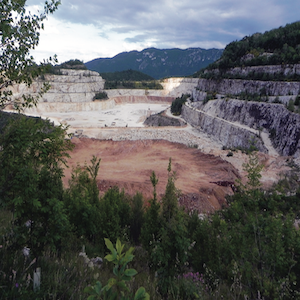Spontaneous renaturalization of open ecosystems in the hills of Brescia seen through the bird community

Accepted: 17 May 2023
All claims expressed in this article are solely those of the authors and do not necessarily represent those of their affiliated organizations, or those of the publisher, the editors and the reviewers. Any product that may be evaluated in this article or claim that may be made by its manufacturer is not guaranteed or endorsed by the publisher.
Authors
The sun-exposed open areas of the Brescia hills overlooking the Po Valley (Avanalpica region) were created by man starting from the 11th century. After the Second World War, following agro-pastoral abandonment, these areas have significantly shrunk. The evolution underway is towards the deciduous forest although in some areas the strong presence of quarries is blocking the vegetational succession or delaying it. Local birds are now largely associated with woodland coenosis and more scarcely with open areas, shrublands and wood edges. Seven open areas species have become extinct over the past 30 years: Woodchat Shrike, Barred Warbler, Rufous-tailed Rock-Thrush, Eastern Black-eared Wheatear, Tawny Pipit, Corn Bunting and Ortolan Bunting. Others, like Red-backed Shrike, Common Whitethroat, Cirl Bunting and Wood Lark have declined. Only the generalist Sardinian Warbler and Blue Rock-Thrush, typical of rocky areas with grassy spaces, are still relatively widespread although slightly decreasing. The Cirl Bunting, a species linked to traditional vineyards and orchards, is not expanding in the new intensively cultivated lands. The Eastern Subalpine Warbler is on the rise even though, due to its very low presence and lack of specific surveys, it may not have been detected in the past. The factors determining the presence of these species, i.e. traditional crops, flat open areas, soils with low grass and often with outcropping and/or rocky substrate, are in sharp decline. We can state that this bird community is negatively influenced by the percentage of tree cover and positively influenced by the presence of quarries which, however, represent an ephemeral and strongly impacting environment. In the absence of fires and/or natural disasters as well as human interventions, which are not likely to occur due to their poor economic sustainability, the prognosis for these birds is to be considered poor and a reduction in both bird and general biodiversity is to be expected.
Downloads
Citations
PlumX Metrics
PlumX Metrics provide insights into the ways people interact with individual pieces of research output (articles, conference proceedings, book chapters, and many more) in the online environment. Collectively known as PlumX Metrics, these metrics are divided into five categories to help make sense of the huge amounts of data involved and to enable analysis by comparing like with like.
How to Cite

This work is licensed under a Creative Commons Attribution-NonCommercial 4.0 International License.
PAGEPress has chosen to apply the Creative Commons Attribution NonCommercial 4.0 International License (CC BY-NC 4.0) to all manuscripts to be published.
Similar Articles
- Corrado Battisti, Aldo Boano, Michele Cento, Amedeo Circosta, Sergio Muratore, Waders (Aves, Charadriiformes) in a Mediterranean remnant wetland: a year-round pilot study evidences contrasting patterns in diversity metrics , Rivista Italiana di Ornitologia: Vol. 85 No. 1 (2015)
- Gianluca Rassati, The Hazel Grouse, Bonasa bonasia, in two sample areas in the Carnic Alps (Friuli-Venezia Giulia, north-eastern Italy) , Rivista Italiana di Ornitologia: Vol. 81 No. 2 (2011)
- Gianluca Rassati, Responsiveness to acoustic stimulation, distribution and habitat preferences of the Lesser Spotted Woodpecker, Dendrocopos minor, in Friuli-Venezia Giulia (North-eastern Italy) , Rivista Italiana di Ornitologia: Vol. 85 No. 1 (2015)
- Luca Puglisi, Paola Bartolommei, Monitoring of nocturnal birds in Tuscany , Rivista Italiana di Ornitologia: Vol. 82 No. 1-2 (2012)
- Corrado Battisti, Giuseppe Dodaro, Breeding bird communities in a morain landscape (Affi, North-Western Venetia): a preliminary survey. , Rivista Italiana di Ornitologia: Vol. 81 No. 2 (2011)
- Marco Masseti, The lost cranes of the island of Lampedusa (Italy) , Rivista Italiana di Ornitologia: Vol. 86 No. 1 (2016)
- Andrea Amici, Fioravante Serrani, Settimio Adriani, Bruno Ronchi, Marco Bonanni, Riccardo Primi, A nesting area suitability model (MISN) to estimate the population parameters of Rock Partridge, Alectoris graeca orlandoi, in Rieti and Frosinone Provinces , Rivista Italiana di Ornitologia: Vol. 82 No. 1-2 (2012)
- Enrico Bassi, Enrico Viganò, Gianfranco Scieghi, New breeding of Eurasian Dotterel Eudromias morinellus in the Italian Alps , Rivista Italiana di Ornitologia: Vol. 84 No. 1 (2014)
- Alessandro Franzoi, Simone Tenan, Paula Lorenzo Sanchez, Paolo Pedrini, Temporal trends in abundance and phenology of migratory birds across the Italian Alps during a 20-year period , Rivista Italiana di Ornitologia: Vol. 91 No. 2 (2021)
- Fabio Saporetti, Steady turnover in a bird community in a periurban landscape in Northern Italy: a look at the change in species richness over time , Rivista Italiana di Ornitologia: Vol. 92 No. 2 (2022)
<< < 1 2 3 4 5 6 7 8 9 10 > >>
You may also start an advanced similarity search for this article.


 https://doi.org/10.4081/rio.2023.667
https://doi.org/10.4081/rio.2023.667



